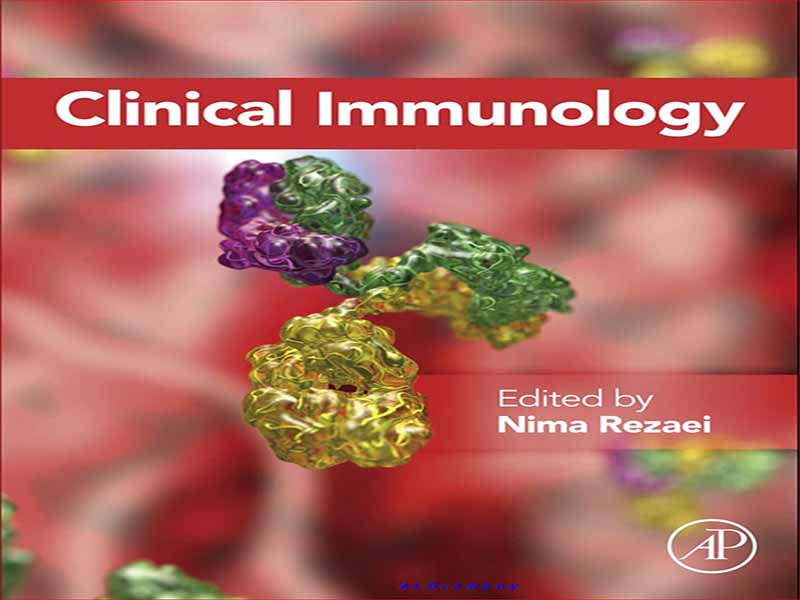- عنوان کتاب: CLINICAL IMMUNOLOGY
- نویسنده: NIMA REZAEI
- حوزه: ایمونولوژی
- سال انتشار: 2023
- تعداد صفحه: 700
- زبان اصلی: انگلیسی
- نوع فایل: pdf
- حجم فایل: 5.26 مگابایت
تصور کنید که شما موجودی باستانی و احتمالاً اجداد دور همه پستانداران هستید. زندگی شما بر یک سیستم دفاعی ابتدایی متکی است. اگر توسط یک انگل یا میکروب مورد حمله قرار می گیرید، با آزاد کردن سلول های فاگوسیتیک یا تولید و انتشار مواد شیمیایی علیه آن، از آسیب رساندن آن به شما جلوگیری می کنید. حالا تصور کنید که در طول تکامل، به موجود پیچیدهتری تبدیل میشوید و به زودی متوجه میشوید که به یک سیستم دفاعی پیچیدهتر نیاز دارید تا از شما در برابر همه عوامل بیماریزا محافظت کند. همچنین، این سیستم دفاعی نباید به بافتهای شما حمله کند یا به زندگی مشترک شما آسیب برساند. این سیستم دفاعی “سیستم ایمنی” نامیده می شود. سیستم ایمنی یکی از باورنکردنی ترین سیستم های بدن انسان است. از شبکه وسیعی از سلولها، مواد شیمیایی، بافتها و اندامها تشکیل شده است که از بدن ما در برابر مهاجمان بیماریزا مانند باکتریها، قارچها، ویروسها و انگلها محافظت میکند و میتواند خاطره مهاجمان را برای دفاع از میزبان در برابر هرگونه حمله حفظ کند. برخوردهای بعدی علاوه بر این، سیستم ایمنی نقش کلیدی در پاتوژنز سرطان و کنترل رشد سلول های سرطانی دارد. روشهای ایمنی درمانی مختلفی برای درمان سرطان تایید شدهاند، و برخی از آنها، یعنی مهارکنندههای ایمون بازرسی برای تومورهای جامد و درمان سلولهای T CAR برای بدخیمیهای هماتولوژیک، پیشرفتهایی در درمان سرطان هستند. هر گونه انحراف از عملکرد طبیعی سیستم ایمنی منجر به ایجاد اختلالات سیستم ایمنی می شود که می تواند با فعالیت کم غیرعادی یا فعالیت بیش از حد سیستم ایمنی مشخص شود. نقص ایمنی گروهی از بیماریهای سیستم ایمنی هستند که در آن میزبان قادر به پاسخگویی مناسب و حفاظتی به عوامل بیماریزا نیست و بر اساس علل ژنتیکی و محیطی بیماری به ترتیب به دو دسته اولیه و ثانویه تقسیم میشوند. هر گونه نقص عملکردی، رشدی، تکثیر یا تمایز یک یا چند جزء سیستم ایمنی منجر به ایجاد نقص ایمنی می شود. سایر انواع اختلالات سیستم ایمنی، از جمله بیماری های خود ایمنی و آلرژی، با فعال شدن سیستم ایمنی در غیاب هر گونه پاتوژن یا تومور، یا فعال شدن پاسخ ایمنی ذاتی و آزاد شدن واسطه های التهابی بدون هیچ گونه شواهدی از پاسخ آنتی ژن-ایمنی مشخص می شوند. در مورد بیماری های خود ایمنی یا ایجاد پاسخ های ایمنی نامطلوب در برابر آلرژن ها در مورد آلرژی. علاوه بر ایجاد بیماریهای سیستم ایمنی، در نتیجه پاسخهای غیرطبیعی ایمنی، این پاسخهای نامناسب میتوانند منجر به پس زدن سلولها، بافتها و اندامهای پیوندی شوند. پیوند روشی است که در آن سلولها، بافتها یا اندامهای یک فرد با سلولهای فرد دیگر یا همان فرد جایگزین میشود. سیستم ایمنی که برای دفاع از میزبان در برابر آنتی ژن های خارجی طراحی شده است، ممکن است علیه سلول ها، بافت ها یا اندام های پیوندی عمل کرده و باعث پس زدن شود. در این کتاب پس از مقدمه ای بر سیستم ایمنی (فصل 1)، تعریف، اپیدمیولوژی، پاتوژنز، ویژگی های بالینی، تشخیص و درمان بیماری های آلرژیک از جمله آسم، رینیت آلرژیک، ملتحمه آلرژیک، کهیر و آنژیوادم، درماتیت آتوپیک، و درماتیت تماسی آلرژیک، آلرژی غذایی و سندرم های گوارشی، آلرژی دارویی و آنافیلاکسی مورد بحث قرار گرفته است (فصل 2). پس از آن، سلولهای ایمنی و پاسخهای ایمنی، که در واکنش خودایمنی، شروع، و تسهیل خودایمنی، بیماریهای خودایمنی چند سیستمی انسان، و برخی بیماریهای خودایمنی اختصاصی سیستم رایجتر نقش دارند، بررسی میشوند (فصل 3). این کتاب تعامل بین سیستم ایمنی و سلول های تبدیل شده را مورد بحث قرار می دهد و مروری به روز در مورد کاربرد ایمونوتراپی برای انواع مختلف سرطان، درمان ترکیبی و ویرایش ایمنی پس از سایر رویکردهای درمانی ارائه می دهد (فصل 4). سپس انواع بیماری های نقص ایمنی، تشخیص احتمالی و درمان آنها را ارائه می کند (فصل 5). همچنین، تعریف و اپیدمیولوژی، مکانیسمهای مولکولی، تشخیص و درمان بیماریهای عفونی (فصل ششم) و انواع مختلف پیوند، ایمنیزایی پیوند، فرآیند تطابق اهداکننده و گیرنده، شرطیسازی قبل از پیوند و عوارض پس از پیوند، و راههای مدیریت آنها (فصل 7) در این کتاب بررسی شده است. امیدوارم که این کتاب مورد استقبال دانشمندان پایه و پزشکانی قرار گیرد که مایلند دانش خود را در زمینه ایمونولوژی بالینی گسترش دهند.
Imagine that you are an ancient being and probably a distant ancestor of all mammals. Your life relies on an elementary defense system. If you are attacked by a parasite or microbe, you stop it from harming you by releasing phagocytic cells or producing and unleashing chemicals against it. Now, imagine that during evolution, you become a more sophisticated being, and soon you realize that you need a more complex defense system in order to protect you against all pathogens. Also, this defense system must not invade your own tissues or harm your cohabitants. This defense system is called “Immune system.” The immune system is one of the most incredible systems of the human body. It is made up of a vast network of cells, chemicals, tissues, and organs that protects our body from pathogenic invaders such as bacteria, fungi, viruses, and parasites, and it can keep a memory of the invaders to defend the host from any further encounters. In addition, the immune system plays a key role in the pathogenesis of cancer and controlling the growth of cancer cells. Various immunotherapeutic approaches have been approved for cancer treatment, and some of them, namely immune checkpoint inhibitors for solid tumors and CAR T-cell therapy for hematologic malignancies, are breakthroughs in cancer treatment. Any aberration from normal function of the immune system leads to the development of immune system disorders, which can be characterized by abnormally low activity or overactivity of the immune system. Immunodeficiencies are a group of immune system diseases in which the host is incapable of responding to the pathogens, properly and in a protective fashion, and they are divided into primary and secondary based on genetic and environmental causes of the disease, respectively. Any functional, developmental, proliferative, or differentiation defect of one or more components of the immune system results in the development of immunodeficiencies. Other types of immune system disorders, including autoimmune diseases and allergies, are characterized by activation of the immune system in the absence of any pathogens or tumor, or activation of innate immune response and releasing of inflammatory mediators without any evidence of an antigen-immune response in the case of autoimmune diseases or development of unfavorable immune responses against allergens in the case of allergies. Besides the development of immune system diseases, as a result of abnormal immune responses, these inappropriate responses can also lead to the rejection of the transplanted cells, tissues, and organs. Transplantation is a procedure in which cells, tissues, or organs of an individual are replaced by those of another individual or the same person. The immune system, which is designed to defend the host against foreign antigens, may act against the transplanted cells, tissue, or organ and cause rejection. In this book, after an introduction to the immune system (Chapter 1), the definition, epidemiology, pathogenesis, clinical features, diagnosis, and treatment of allergic diseases, including asthma, allergic rhinitis, allergic conjunctivitis, urticaria and angioedema, atopic dermatitis, and allergic contact dermatitis, food allergy and gastrointestinal syndromes, drug allergy, and anaphylaxis are discussed (Chapter 2). Afterward, the immune cells and immune responses, which are involved in autoimmune reaction, initiation, and facilitation of autoimmunity, human multisystem autoimmune diseases, and some more common system-specific autoimmune diseases, are reviewed (Chapter 3). This book discusses the interaction between the immune system and transformed cells and provides an updated review on the application of immunotherapy for different cancer types, combination therapy, and immunoediting after other therapeutic approaches (Chapter 4). Then, it presents the types of immunodeficiency diseases, their possible diagnosis, and treatment (Chapter 5). Also, the definition and epidemiology, molecular mechanisms, diagnosis, and treatment of infectious diseases (Chapter 6) and different types of transplantations, the immunopathogenesis of transplantation, the process of matching the donor and the recipient, pretransplantation conditioning, and complications after transplant, and ways to manage them (Chapter 7) are reviewed in this book. I hope that this book will be welcomed by basic scientists and clinicians who wish to extend their knowledge in the field of clinical immunology.
این کتاب را میتوانید بصورت رایگان از لینک زیر دانلود نمایید.
Download: CLINICAL IMMUNOLOGY

































نظرات کاربران